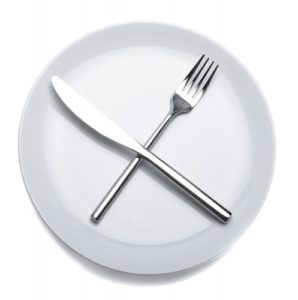 It’s good to go without
It’s good to go without
The fact that you are sitting here reading this document is proof positive that you have descended from a long line of great hunters. But even the best hunters come up short some days. Although game was usually readily available, there were times of drought or severe weather – and probably just some days with bad luck – when the hunters came home empty-handed. Maybe the fish weren’t biting, the big one got away, or maybe there was a noisy guy in the bunch that scared away the game. Regardless, food was always at a premium and some days our ancestors had to go without. And so should you.
A powerful technique to reverse metabolic derangement and normalize insulin sensitivity, blood sugar, cholesterol, blood lipids and energy levels is to practice intermittent fasting.
Your body was not designed to have a constant food supply at arm’s reach. The ready supply of calorie-dense foods and its resulting consequence (a generally sedentary lifestyle) has led to an over-fed and under-active, over-weight and under-muscled population that is riddled with sickness and disease. One effective step towards righting this unnatural lifestyle is to skip a meal or two.
We are not promoting calorie deprivation or hunger pains, but the human body has been shaped over thousands of generation to expect periods without food. In these times of fasting, the digestive track empties and gets a chance to rest and repair. The liver and lymphatic system has the opportunity to catch up and cleanse the body of toxicity. Your metabolism re-calibrates and blood profiles begin to normalize. You become a more efficient fat burner. And when done properly, your body can reduce systemic inflammation.
Observation of this Paleolithic Rhythm of rest and rejuvenation can be done in many ways. Each person will respond to fasting uniquely, based on a host of physical traits, conditions and lifestyle factors. Considerations include age, weight, activity level, how often and hard you exercise, your diet-style, stress level and sleep patterns.
Intermittent Fasting implies that you choose to have predetermined periods of time that you go without food.
Conventional “wisdom” would suggest that going without food for any considerable period of time would simply slow your metabolism and promote fat storage and cannibalization of lean muscle tissue for energy. This can happen with prolonged caloric restriction diets. This will not happen if intermittent fasting is done properly.
Consider these Bonfire best practices for cycling your Digestive Rhythm:
- Choose 1 or 2 days per week to have a shorter window for food consumption. For example: Mondays and Thursdays, only eat between Noon and 6 PM (an 18 hour fast)
- Or try 1 day per week to go food-free (24 hour fast)
- Or try to have a day with only vegetable juice or raw food
You can get creative – as your ancestors did. The big idea is to give your system a rest. Some general vital behaviors to complement your fasting include only consuming healthy foods when you do eat. Eating periods around fasting are not times to “cheat” and fill yourself with toxic and/or deficient foods.
Be sure to stay active, exercise and rest well. You will find that your energy level is better when you are fasting because your body is burning fat for fuel and your blood sugar is normalizing. Diabetics and people with heart disease or cancer should have their blood chemistry monitored during these periods because the effects can be profound – and very encouraging.

 It’s good to go without
It’s good to go without


